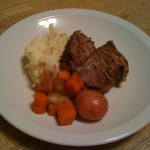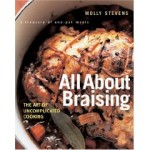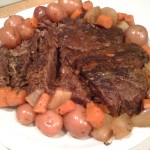 When I was a child and young teen, among my favorite dishes were my mother’s beef stew and Yankee pot roast. My mother is a fantastic cook all around, and in those days, as a single mother working long hours, with both of us hating the chill of winter, braises took care of three essentials: Less time in the kitchen, plenty of leftovers to eat for the week, and the warming of our bones. I’m not certain she made braises for that purpose consciously, it’s just common sense. About braises, these essentials hold true.
When I was a child and young teen, among my favorite dishes were my mother’s beef stew and Yankee pot roast. My mother is a fantastic cook all around, and in those days, as a single mother working long hours, with both of us hating the chill of winter, braises took care of three essentials: Less time in the kitchen, plenty of leftovers to eat for the week, and the warming of our bones. I’m not certain she made braises for that purpose consciously, it’s just common sense. About braises, these essentials hold true.
Then there were the hours upon torturous hours that my mother would leave the roast braising all day, and with the air permeated with the aroma of beef, wine and bay, I’d be salivating for what seemed like forever. Worse, there was no eating it the same night, as it would be better the next day. Oh, the agony of waiting!

 So it is hardly surprising that I should fall in love with “All About Braising,” by Molly Stevens. In my opinion, the finest book on braising I’ve encountered. From the why and wherefore to technique; from what cuts of meat to clear, concise recipes that work. If you are as much of a fan of braised dishes as I am, this is the book for you.
So it is hardly surprising that I should fall in love with “All About Braising,” by Molly Stevens. In my opinion, the finest book on braising I’ve encountered. From the why and wherefore to technique; from what cuts of meat to clear, concise recipes that work. If you are as much of a fan of braised dishes as I am, this is the book for you.
In addition to beef recipes, there are several for vegetables, seafood, pork, lamb, and chicken. The hearty chicken and herb dumplings are fabulous comfort food, and the pork pot roast with apricots, cardamom and ginger is a feast for the senses. I’ve probably cooked more from this book in the couple of months I’ve owned it than any other new book in the same period of time.
As the dreadful cold appears to have settled in for the foreseeable future, I highly recommend this mouth-watering pot roast to treat the symptoms of winter. By adding the root vegetables late in the braising process, they retain their flavor, enhanced by the herbs and braising liquid, and become rather meaty themselves. I served it along buttery mashed potatoes. What’s that you ask? Why yes, there are potatoes in the pot roast as well. One can never have too many potatoes.
This recipe has instructions to broil the roast in order to brown it. I skipped this and browned the roast directly in the braising pan on the stove. I felt the flavor of the fond (the brown bits left behind in the pan from browning meat) would enhance the flavor of the pot roast, as I was using store bought stock, which always needs a little help in the flavor department.

Yankee Pot Roast Redux
by Molly Stevens
from All About Braising: The Art of Uncomplicated Cooking
© W. W. Norton & Company, 2004
Serves 6 | Braising Time: About 3 Hours
– One 3.5 to 4-pound boneless beef chuck roast
– Coarse salt and freshly ground black pepper
– 1 bay leaf
– 1 medium yellow onion (about 6 ounces), peeled
– 3 whole cloves
– 1/4 cup hard cider or dry white wine
– 1 cup beef, veal, or chicken stock
– 1 1/2 teaspoons chopped fresh thyme or 1/2 teaspoon dried
– 1/2 pound small white or red potatoes, peeled and, if larger than 1 1/2 inches, cut into halves or quarters
– 2 large carrots, peeled and cut into 1 1/2-inch lengths
– Fleur de sel or coarse sea salt for serving (optional)
1. Tying the meat: Tie the roast with kitchen string so that it is snug and neat (see instructions in the book, page 258). Season all over with salt and plenty of pepper and place in a shallow baking pan (2- to 3-quart).
2. Browning the meat: Heat the broiler to high. Slide the roast under the broiler so that the surface is about 6 inches away from the element. Broil until the fat begins to sizzle and the surface begins to caramelize but not char, about 5 minutes. Turn with tongs and broil on the other side (or sides, depending on the shape of the roast) for another 5 minutes (each). Remove the roast from the broiler, and heat the oven to 300 degrees. (Alternatively, you can brown the roast in the braising pan according to the instructions on [cookbook] page 254.)
With tongs, transfer the seared roast to a Dutch oven or other heavy lidded braising pan (4-quart capacity). Tack the bay leaf to the onion using the cloves and tuck it into the pot alongside the beef.
3. The braising liquid: Pour off any excess fat from the pan you used to brown the beef and set over medium-high heat. Add the cider or wine and bring to a boil, scraping the bottom with a wooden spoon to dissolve any precious bits of caramelized beef juices that have stuck there. Continue to boil until the liquid is reduced by half, 3 to 4 minutes. Add the stock and let it come to a boil. Pour the boiling liquid over the beef and sprinkle with the thyme.
4. The braise: Cover the roast with parchment paper, pressing down so that the paper almost touches the meat and the edges extend about an inch over the sides of the pot. Then set the lid in place and slide the pot into the lower third of the oven to braise. Check to see that the liquid isn’t simmering too fiercely after the first 10 to 15 minutes. If it is, lower the oven temperature 10 or 15 degrees. After 45 minutes, turn the roast with tongs. Continue braising at a gentle simmer for another 45 minutes.
Turn the roast again, and add the turnips, potatoes, and carrots to the pot, spooning some of the braising liquid over the meat before returning the parchment paper and lid. Continue braising until the meat is fork-tender and the vegetables are easily pierced with the tip of a knife, another 1 1/2 hours or so (for a total of about 3 hours).
5. The finish: Transfer the roast to a carving board or serving platter. With a slotted spoon, remove the vegetables and arrange them around the meat (discard the clove-studded onion). Cover loosely with foil to keep warm. Set the Dutch oven over medium heat, and skim the surface fat from the braising liquid as it comes to a simmer. Evaluate the braising liquid: if it appears too thin or watery, boil the liquid to reduce the volume and thicken up slightly, about 10 minutes. It should be the consistency of a slightly thickened vinaigrette.
6. Serving: Cut the strings from the roast and slice into 1/2 inch thick slices. Serve slices of the pot roast alongside a mix of vegetables, with the braising liquid ladled on top. Pass the fleur de sel or coarse sea salt at the table, if desired.
© 2010, taetopia. All rights reserved.
That looks delish. And even more delicious are your descriptions of your mother’s cooking! Yum.
[…] know I said I’d cook more using recipes from my vast collection of cookbooks, but it was just one of […]